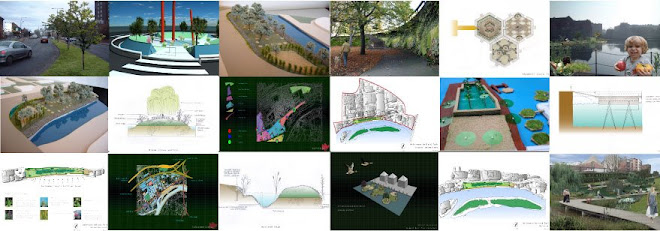
Our Focus weeks are designed for us to visit sites, take part in voluntary work, research design practice or attend seminars or lectures, all in aid of furthering our personal direction within the course, and also in our futures of landscape architecture.
I started off visiting the new living wall at Westfiled Shopping Centre in Shepherd's Bush. This got me really excited! I really am a sucker for a green wall or roof.....
The wall is formed like a wave, gently flowing its way down along the path. At it's base is a water feature of layered granite, with flush lighting creating a lovely atmosphere at night.
I have been reading Jan Gehl's Life Between Buildings and actually just got to the seating part in the book. Jan talks about how people do not like to sit in public with their backs exposed, and how built-in seating or areas that were non-designed sometimes are the best design. Applying this to the wall and fountains, I do think the Landscape Architects EDAW had this in mind as the base of the water feature makes for perfect seating, and while it weaves it's way down, the curves are enough to allow for a semi-private chat.
With regards to the planting, EDAW originally specified two-litre plants, then upgraded to 10 and 20 litre specimens to make it look better, with stock sourced from Tendercare and planted up all within a week of it's official opening by London mayor Boris Johnson.
I love it, I am jealous of it, I am so pleased it's close to my home. I will be there in summer!
 On Friday evening I attented a lecture at Birkbeck University, part of a free lecture series for Spring 09 encompassing all freshwater habitat issues in the UK. This particular lecture was presented by Paul Raven, Head of conservation and Ecology at the Environment Agency in Bristol and entitled 'Getting on with the job: taking practical action for freshwater ecology and conservation'.
On Friday evening I attented a lecture at Birkbeck University, part of a free lecture series for Spring 09 encompassing all freshwater habitat issues in the UK. This particular lecture was presented by Paul Raven, Head of conservation and Ecology at the Environment Agency in Bristol and entitled 'Getting on with the job: taking practical action for freshwater ecology and conservation'. Client of Environment Agency
Client of Environment Agency Barton Broads Picture courtesy of http://www.ukcpi.org/
Barton Broads Picture courtesy of http://www.ukcpi.org/










 Everything about this sea bath is great....its material quality, the obvious sculpural shape and protection it provides, and of course that it's free to the public, but another fantastic point is its availability and use for everyone, young and old, able and disabled, and it's design allowing for playful peaceful day or evening swims or maybe a morning intense exercise.
Everything about this sea bath is great....its material quality, the obvious sculpural shape and protection it provides, and of course that it's free to the public, but another fantastic point is its availability and use for everyone, young and old, able and disabled, and it's design allowing for playful peaceful day or evening swims or maybe a morning intense exercise.










